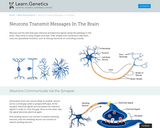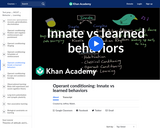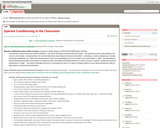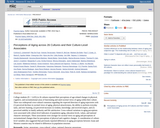
This resource describes how neurons transmit messages in the brain.
- Subject:
- Social Studies
- Material Type:
- Reading
- Provider:
- University of Utah/Genetic Science Learning Center
- Date Added:
- 01/04/2017

This resource describes how neurons transmit messages in the brain.

This lesson plan celebrates the recent Nobel Prize for Medicine award winners for their work on how cells move molecular “cargoâ€. Students will be introduced to the specialized brain cell – the neuron – and how neurotransmission occurs between neurons. Included is a PDF (to be used like a powerpoint), a giant puzzle of a neuron, and a “dance party†activity to help reinforce the concept of neurotransmission.

In this lesson, students gain knowledge about the different types of neurotransmitters.

This resource describes recent developments that have led to a portable, powerful new technology to help in diagnosing mental illness.

Noba is a high-quality, flexibly structured digital introduction to psychology resource for higher-ed classrooms and virtual classrooms. Noba consists of nearly 90 short (2500-4000 word) chapters authored by leading instructors and researchers including 7 winners of the William James Award. Chapters are organized in familiar categories (Development, Learning & Memory, Personality, etc.) for easy reference. All Noba materials are licensed through Creative Commons under the CC BY-NA-SA license terms.
The Noba website allows anyone to combine chapters in any order to create unique psychology textbooks to suit virtually any curriculum. In addition to allowing users to build their own customized collections, Noba provides a series of "Ready-Made" digital textbooks curated from the Noba chapters to conform to the scope and sequence of some of the most commonly taught 100/200-level psych courses (Intro-to-Psych, Psych as a Biological Science, Psych as a Social Science, etc.). The Ready-made books can also be edited to add or remove chapters, or sections so that they better conform to the specific course an instructor will teach.
Custom-made books, Ready-made books, or even individual chapters can be used online, downloaded as PDFs or shared withe learners via email and social media using easy-share tools built in to the website.

This resource discusses generalization in qualitative research.

This presentation discusses the individualism and collectivism theory.

This video discusses operant conditioning and escape and avoidance learning.

This video discusses operant conditioning and innate vs learned behaviors.

This video discusses operant conditioning and postive and negative reinforcement and punishment.

In this activity, students learn the difference between rewards and punishments by role playing.

This resource explains organic mental disordes.

This resource explains organic brain injury.

This video introduces the general external topography of the brain. To illustrate the relationship between specific behaviors and brain function, the video begins by showing a racecar driver exercising his skill, and then presents graphic illustrations of the internal activity of his brain. The video reviews several methods of studying brain activity including the CAT scan, PET scan, EEG, and MRI.

This resource descusses Eysenck's theory of personality and contains questionnaires.

This research article studied aging across 26 cultures.

This resource discusses theories of personality, pitfalls, philosophical assumptions, and organization.

This resource explains personality traits and inlcudes a mini personality assessment.

In this lesson, students are made aware of the fact that they develop intellectually and perform two versions of Piaget's experiments to see if they are cognitive thinkers, or do they act on the formal operational level.

For this activity, one student portrays a psychologist and the other students portray a patient with a psychological disorder. Students complete a chart to identify suspected causes of the disorder, common symptoms of the disorder, how the disorder interferes with daily life, and known treatments for the disorder.